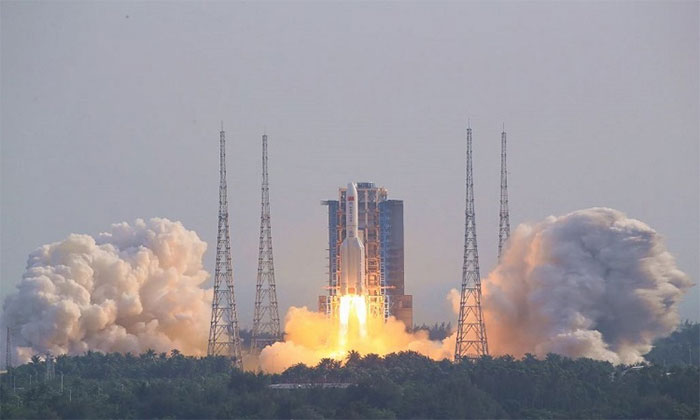China Successfully Launches the Dreaming Sky Module, Moving Closer to Completing Its Space Station in Earth Orbit.
The Long March rocket carrying the Dreaming Sky module lifts off. (Video: CGTN)
At 3:37 PM on October 31, the Dreaming Sky experimental module launched aboard the Long March 5B heavy-lift rocket from the Wenchang Satellite Launch Center on Hainan Island, southern China. Deng Hongqin, director of the Xichang Satellite Launch Center, announced the successful launch at approximately 3:50 PM the same day.
Scheduled to connect with the central module of the Tiangong space station within hours of launch, the 18-meter-long, 23-ton Dreaming Sky module—equivalent to four adult Asian elephants—will be monitored during docking by astronauts Chen Dong, Liu Yang, and Cai Xuzhe, who have been aboard the Tiangong station since June 2022. The launch date coincides with the anniversary of the passing of Qian Xuesen, the father of China’s rocket program, who died on October 31, 2009. At an altitude of over 380 km above Earth, the Dreaming Sky will later reposition itself via a robotic arm to transform the Tiangong station into a T-shape, marking the completion of its construction phase.
It took China less than two years to assemble the Tiangong space station, which consists of three modules in orbit, starting with the central module, Tianhe, launched in April of last year. Compared to Tianhe and the other experimental module, Wentian (launched into orbit in July 2022), the Dreaming Sky is equipped with more research facilities and will support a variety of physics experiments in a microgravity environment.

China successfully launches the Dreaming Sky module.
For instance, the ultra-cold atomic physics facility will use lasers to cool atoms to 10 picokelvins, less than one billionth of a degree above absolute zero (-273.15 degrees Celsius). This will be the lowest temperature ever achieved by humanity. The Dreaming Sky will be equipped with three state-of-the-art atomic clocks, including the world’s first optical atomic clock in space. These clocks can work together to time events with ultra-high precision, deviating no seconds over more than a billion years.
According to the China Manned Space Agency (CMSA), the Dreaming Sky will host a total of nine large experimental facilities the size of refrigerators. Additionally, there will be a room for astronauts to work and store items. Meanwhile, there are 37 external converters on the Dreaming Sky module to support experiments and research on the effects of cosmic radiation on living organisms and crops. The module will also facilitate the release of microsatellites and CubeSats from orbit. Like Wentian, the Dreaming Sky will utilize two large solar panel arrays with a total wingspan of 56 meters when extended to help power the Tiangong station.
To date, the CMSA has approved over 100 experimental proposals from Chinese researchers. At least 25 projects are currently underway, including experiments studying protein crystallization and the effects of microgravity on plant cells, bones, and muscles, according to reports in Nature. Astronauts have brought 12,000 seeds, including eggplant and watermelon, to the Tiangong station, allowing them to be exposed to radiation and microgravity for six months before returning them to Earth for planting in April.
It is anticipated that the Tiangong station will host over 1,000 scientific experiments throughout its operational lifespan, including an international project between the CMSA and the United Nations Office for Outer Space Affairs. In November, China plans to launch Tianzhou 5—the fourth cargo mission to the Tiangong station to supply materials for the upcoming crewed Shenzhou 15 mission.
The Tiangong Station and the International Space Station (ISS) are the two operational space stations in low Earth orbit. While the ISS is expected to fall out of orbit in the early 2030s, the Tiangong station has the potential to expand from three to six modules, according to Chinese authorities.


















































